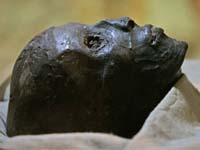Researchers Inkle That King Tut Was Lame
The legendary Egyptian king Tutankhamun, commonly known as King Tut, died of conditions including malaria and complications from a leg fracture, according to a study published this week in the Journal of the American Medical Association.

Tutankhamun's tomb was discovered in 1922, but his life remains shrouded in mystery, and not much is known about him. He ruled during the 18th Dynasty, from 1336-1327 B.C., and is believed to have died young. Forensic analysis of his mummy has put his age of death at about 17 to 19 years.
In the study researchers used anthropological, radiological and genetic testing to examine Tut and 10 other bodies mummified over a two-year period during Tut's dynasty.
Previously, based on historical records and earlier digs, Zahi Hawass, the lead investigator of the study, had said Tut could have been the son of Amenhotep III, a successful and popular king of the 18th Dynasty, who was later known as Akhenaten.
Through DNA, Hawass' researchers determined that was indeed the case, and that Tut was married to his sister. Scientists believe that genetics and inherited diseases played a role in Tut's health because of inbreeding within the family.
"We know there were weaknesses in these mummies, perhaps even cardiovascular problems," Hawass said.
When researchers scanned Tut's mummy, they found he not only had severe kyphoscoliosis, or curvature of the spine, but also suffered from a toe malformation known as oligodactyly. The condition made his left foot swell, and it would have caused excruciating pain when he walked.
"In ancient drawings we see Tut shooting arrows, not standing, but sitting in a chariot. This was unusual," Hawass said. "In his tomb, we also found 100 walking sticks. Originally we thought they represented power. But they were ancient crutches that he obviously used. He could barely stand."
Hawass said by taking his prior research and combining it with his most recent findings, the cause of Tut's death became pretty clear to him.
"The purpose of the CT scan (in 2005) was to see if he was murdered, because earlier X-rays had found there was a hole in his skull," Hawass said. "But we found the hole was made during mummification. However, we did find a large fracture in his left femur that probably contributed to his death."
Hawass theorized a fall could have hastened Tut's death. But DNA testing also showed evidence of plasmodium falciparum, a protozoan parasite that causes malaria in humans. The parasite has been found in many other mummies, as well. Hawass said he believes the combination of the serious fracture and the deadly parasite killed the young king.
"This is very exciting that we can take modern technology and learn more about Egyptian history," said Howard Markel, a medical historian at the University of Michigan's Center for the History of Medicine.
"Mummies are very powerful tools," he said. "We can learn a lot from the dead, how illnesses evolve."
CNN news agency has contributed to the report.
Subscribe to Pravda.Ru Telegram channel, Facebook, RSS!





